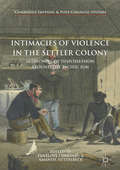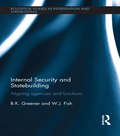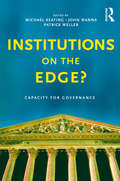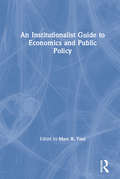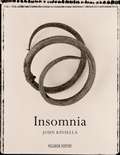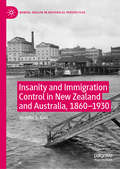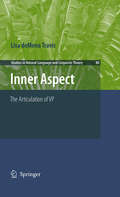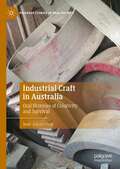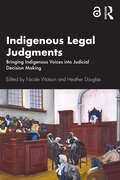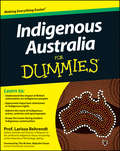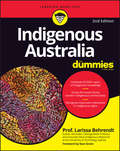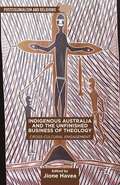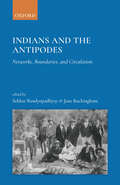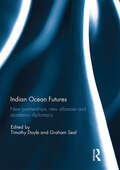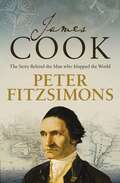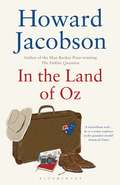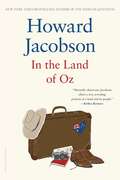- Table View
- List View
Intimacies of Violence in the Settler Colony: Economies of Dispossession around the Pacific Rim (Cambridge Imperial and Post-Colonial Studies Series)
by Penelope Edmonds Amanda NettelbeckViolence and intimacy were critically intertwined at all stages of the settler colonial encounter, and yet we know surprisingly little of how they were connected in the shaping of colonial economies. Extending a reading of ‘economies’ as labour relations into new arenas, this innovative collection of essays examines new understandings of the nexus between violence and intimacy in settler colonial economies of the British Pacific Rim. The sites it explores include cross-cultural exchange in sealing and maritime communities, labour relations on the frontier, inside the pastoral station and in the colonial home, and the material and emotional economies of exploration. Following the curious mobility of texts, objects, and frameworks of knowledge, this volume teases out the diversity of ways in which violence and intimacy were expressed in the economies of everyday encounters on the ground. In doing so, it broadens the horizon of debate about the nature of colonial economies and the intercultural encounters that were enmeshed within them.
Intimacies of Violence in the Settler Colony: Economies of Dispossession around the Pacific Rim (Cambridge Imperial and Post-Colonial Studies Series)
by Penelope Edmonds Amanda NettelbeckViolence and intimacy were critically intertwined at all stages of the settler colonial encounter, and yet we know surprisingly little of how they were connected in the shaping of colonial economies. Extending a reading of ‘economies’ as labour relations into new arenas, this innovative collection of essays examines new understandings of the nexus between violence and intimacy in settler colonial economies of the British Pacific Rim. The sites it explores include cross-cultural exchange in sealing and maritime communities, labour relations on the frontier, inside the pastoral station and in the colonial home, and the material and emotional economies of exploration. Following the curious mobility of texts, objects, and frameworks of knowledge, this volume teases out the diversity of ways in which violence and intimacy were expressed in the economies of everyday encounters on the ground. In doing so, it broadens the horizon of debate about the nature of colonial economies and the intercultural encounters that were enmeshed within them.
Internal Security and Statebuilding: Aligning Agencies and Functions (Routledge Studies in Intervention and Statebuilding)
by B. K. Greener W. J. FishThis book examines international efforts to provide security in post-conflict sites and explains why internal security should be given precedence in statebuilding endeavours. The work begins by exploring the evolution of security sectors in mature liberal democratic states, before examining the attempts of such states to accelerate that evolutionary process in post-conflict sites through statebuilding and security sector reform. These discussions suggest interestingly different answers to the question of who should provide for internal security in international operations. When considering mature states, there are both practical and normative reasons as to why internal security has become the sole domain of police, with military forces being excluded from internal affairs. In peace and stability operations, on the other hand, difficulties with utilising police personnel have led to military forces being required to play internal security roles. This tension is investigated further through detailed case studies of three recent missions: Afghanistan, Timor-Leste and Solomon Islands. These case studies both reinforce and augment the practical and normative reasons for ensuring that internal security remains the domain of police. This then impacts upon peace and stability operations in two important ways. If we are to provide enduring security in post-conflict sites, we should both (i) prioritise internal security agencies in security sector reform efforts, and (ii) prioritise ways of enabling police to play internal security roles in the contributing mission. This book will be of much interest to students of statebuilding, peace and conflict studies, military studies, police studies, historical sociology, security studies and IR in general.
Internal Security and Statebuilding: Aligning Agencies and Functions (Routledge Studies in Intervention and Statebuilding)
by B. K. Greener W. J. FishThis book examines international efforts to provide security in post-conflict sites and explains why internal security should be given precedence in statebuilding endeavours. The work begins by exploring the evolution of security sectors in mature liberal democratic states, before examining the attempts of such states to accelerate that evolutionary process in post-conflict sites through statebuilding and security sector reform. These discussions suggest interestingly different answers to the question of who should provide for internal security in international operations. When considering mature states, there are both practical and normative reasons as to why internal security has become the sole domain of police, with military forces being excluded from internal affairs. In peace and stability operations, on the other hand, difficulties with utilising police personnel have led to military forces being required to play internal security roles. This tension is investigated further through detailed case studies of three recent missions: Afghanistan, Timor-Leste and Solomon Islands. These case studies both reinforce and augment the practical and normative reasons for ensuring that internal security remains the domain of police. This then impacts upon peace and stability operations in two important ways. If we are to provide enduring security in post-conflict sites, we should both (i) prioritise internal security agencies in security sector reform efforts, and (ii) prioritise ways of enabling police to play internal security roles in the contributing mission. This book will be of much interest to students of statebuilding, peace and conflict studies, military studies, police studies, historical sociology, security studies and IR in general.
Institutions on the edge?: Capacity for governance
by Michael Keating John Wanna Patrick WellerAustralia faces major challenges to its forms of governance. Changing expectations from its citizens, global pressures on the economy and technological innovation are impacting on government operations. Yet most of its institutions were designed a hundred years ago. Cabinet government was inherited. Parliament was already established in its forms and procedures. The federal structure, the High Court and the federal public service were created as a consequence. The party structure has been effectively frozen since the 1920s and a tradition of handing some responsibilities to arms-length organisations was well established.So how have these institutions changed over the last hundred years and how well will they adapt to the demands of the modern world? Do they have the capacity to adapt appropriately and enable governments to achieve their preferred outcomes? In this book experienced academics and practitioners explore these questions. They examine each of the institutions in terms of their ability to meet new challenges and provide some hope that Australia's institutions, even if at times slow to move and dominated by internal interests, have a capacity to adapt and govern effectively. The book shows our political institutions in a new light, as dynamic, often flexible organisms; it provides important new insights into the way we are governed and how our system of governance might develop in the future.
Institutions on the edge?: Capacity for governance
by Michael Keating John Wanna Patrick WellerAustralia faces major challenges to its forms of governance. Changing expectations from its citizens, global pressures on the economy and technological innovation are impacting on government operations. Yet most of its institutions were designed a hundred years ago. Cabinet government was inherited. Parliament was already established in its forms and procedures. The federal structure, the High Court and the federal public service were created as a consequence. The party structure has been effectively frozen since the 1920s and a tradition of handing some responsibilities to arms-length organisations was well established.So how have these institutions changed over the last hundred years and how well will they adapt to the demands of the modern world? Do they have the capacity to adapt appropriately and enable governments to achieve their preferred outcomes? In this book experienced academics and practitioners explore these questions. They examine each of the institutions in terms of their ability to meet new challenges and provide some hope that Australia's institutions, even if at times slow to move and dominated by internal interests, have a capacity to adapt and govern effectively. The book shows our political institutions in a new light, as dynamic, often flexible organisms; it provides important new insights into the way we are governed and how our system of governance might develop in the future.
An Institutionalist Guide to Economics and Public Policy
by Marc R. ToolThis narrative recounts the 18th and 19th century "shipping out" of Pacific islanders aboard European and American vessels, a kind of "counter-exploring", that echoed the ancient voyages of settlement of their island ancestors.
An Institutionalist Guide to Economics and Public Policy
by Marc R. ToolThis narrative recounts the 18th and 19th century "shipping out" of Pacific islanders aboard European and American vessels, a kind of "counter-exploring", that echoed the ancient voyages of settlement of their island ancestors.
Insomnia
by John KinsellaThe Australian poet John Kinsella’s vivid and urgent new collection addresses the crisis of being that currently afflicts us: Kinsella addresses a situation where the creations of the human imagination, the very means by which we extend our empathies into the world – art, music and philosophy – suddenly find themselves in a world that not only denies their importance, but can sometimes seem to have no use for them at all. In an attempt to find a still point from which we might reconfigure our perspective and address the paradoxes of our contemporary experience, Kinsella has written poems of self-accusation and angry protest, meditations on the nature of loss and trauma, and full-throated celebrations of the natural world. Ranging from Jam Tree Gully, Western Australia to the coast of West Cork, Ireland, haunted by historical and literary figures from Dante to Emily Brontë (whom Kinsella has obsessed over since he was a child, and who intervenes in the poet’s attempts to come to grips with ideas of colonization and identity), Insomnia may be Kinsella’s most various and powerful collection to date.
Insanity and Immigration Control in New Zealand and Australia, 1860–1930 (Mental Health in Historical Perspective)
by Jennifer S. KainThis book examines the policy and practice of the insanity clauses within the immigration controls of New Zealand and the Commonwealth of Australia. It reveals those charged with operating the legislation to be non-psychiatric gatekeepers who struggled to match its intent. Regardless of the evolution in language and the location at which a migrant’s mental suitability was assessed, those with ‘inherent mental defects’ and ‘transient insanity’ gained access to these regions. This book accounts for the increased attempts to medicalise border control in response to the widening scope of terminology used for mental illnesses, disabilities and dysfunctions. Such attempts co-existed with the promotion of these regions as ‘invalids’ paradises’ by governments, shipping companies, and non-asylum doctors. Using a bureaucratic lens, this book exposes these paradoxes, and the failings within these nineteenth- and early twentieth-century Australasian nation-state building exercises.
Inner Aspect: The Articulation of VP (Studies in Natural Language and Linguistic Theory #80)
by Lisa deMena TravisFinishing this book was one of the most difficult things I have ever done. It took far too long from original idea to page proofs and suffered from being relegated to small corners of my life. It was very rarely on the front burner. Since I started working on this topic in 1991, there has been a lot of interesting work done on the areas of the articulation of VP, phrase structure mirroring event structure, the use of functional categories to represent Aktionsart, and many other areas that the research presented here touches on. The hardest thing about doing a project of this size is to accept that not everyone’s ideas can be addressed and not all new research can be incorporated. The only way that I have found it possible to let this book go to press is to reread the Preface to Events in the Semantics of English by Terence Parsons where he writes, ‘‘The goal of this book is neither completeness nor complete accuracy; it is to get some interesting proposals into the public arena for others to criticize, develop, and build on. ’’ My aim in this book is to make connections between various accounts of various constructions in various languages at the risk of treating each of these too lightly. I am grateful to too many people to thank them individually.
Industrial Craft in Australia: Oral Histories of Creativity and Survival (Palgrave Studies in Oral History)
by Jesse Adams SteinThis book is the first of its kind to investigate the ongoing significance of industrial craft in deindustrialising places such as Australia. Providing an alternative to the nostalgic trope of the redundant factory ‘craftsman’, this book introduces the intriguing and little-known trade of engineering patternmaking, where objects are brought to life through the handmade ‘originals’ required for mass production.Drawing on oral histories collected by the author, this book highlights the experiences of industrial craftspeople in Australian manufacturing, as they navigate precarious employment, retraining, gendered career pathways, creative expression and technological change. The book argues that digital fabrication technologies may modify or transform industrial craft, but should not obliterate it. Industrial craft is about more than the rudimentary production of everyday objects: it is about human creativity, material knowledge and meaningful work, and it will be key to human survival in the troubled times ahead.
Indigenous Legal Judgments: Bringing Indigenous Voices into Judicial Decision Making
by Nicole Watson and Heather DouglasThis book is a collection of key legal decisions affecting Indigenous Australians, which have been re-imagined so as to be inclusive of Indigenous people’s stories, historical experience, perspectives and worldviews.In this groundbreaking work, Indigenous and non-Indigenous scholars have collaborated to rewrite 16 key decisions. Spanning from 1889 to 2017, the judgments reflect the trajectory of Indigenous people’s engagements with Australian law. The collection includes decisions that laid the foundation for the wrongful application of terra nullius and the long disavowal of native title. Contributors have also challenged narrow judicial interpretations of native title, which have denied recognition to Indigenous people who suffered the prolonged impacts of dispossession. Exciting new voices have reclaimed Australian law to deliver justice to the Stolen Generations and to families who have experienced institutional and police racism. Contributors have shown how judicial officers can use their power to challenge systemic racism and tell the stories of Indigenous people who have been dehumanised by the criminal justice system.The new judgments are characterised by intersectional perspectives which draw on postcolonial, critical race and whiteness theories. Several scholars have chosen to operate within the parameters of legal doctrine. Some have imagined new truth-telling forums, highlighting the strength and creative resistance of Indigenous people to oppression and exclusion. Others have rejected the possibility that the legal system, which has been integral to settler-colonialism, can ever deliver meaningful justice to Indigenous people.The Open Access version of this book, available at http://www.taylorfrancis.com, has been made available under a Creative Commons Attribution-Non Commercial-No Derivatives (CC-BY-NC-ND) 4.0 license.
Indigenous Legal Judgments: Bringing Indigenous Voices into Judicial Decision Making
by Nicole Watson Heather DouglasThis book is a collection of key legal decisions affecting Indigenous Australians, which have been re-imagined so as to be inclusive of Indigenous people’s stories, historical experience, perspectives and worldviews.In this groundbreaking work, Indigenous and non-Indigenous scholars have collaborated to rewrite 16 key decisions. Spanning from 1889 to 2017, the judgments reflect the trajectory of Indigenous people’s engagements with Australian law. The collection includes decisions that laid the foundation for the wrongful application of terra nullius and the long disavowal of native title. Contributors have also challenged narrow judicial interpretations of native title, which have denied recognition to Indigenous people who suffered the prolonged impacts of dispossession. Exciting new voices have reclaimed Australian law to deliver justice to the Stolen Generations and to families who have experienced institutional and police racism. Contributors have shown how judicial officers can use their power to challenge systemic racism and tell the stories of Indigenous people who have been dehumanised by the criminal justice system.The new judgments are characterised by intersectional perspectives which draw on postcolonial, critical race and whiteness theories. Several scholars have chosen to operate within the parameters of legal doctrine. Some have imagined new truth-telling forums, highlighting the strength and creative resistance of Indigenous people to oppression and exclusion. Others have rejected the possibility that the legal system, which has been integral to settler-colonialism, can ever deliver meaningful justice to Indigenous people.The Open Access version of this book, available at http://www.taylorfrancis.com, has been made available under a Creative Commons Attribution-Non Commercial-No Derivatives (CC-BY-NC-ND) 4.0 license.
Indigenous Australia for Dummies (For Dummies Ser.)
by Larissa BehrendtA comprehensive, relevant, and accessible look at all aspects of Indigenous Australian history and culture What is The Dreaming? How many different Indigenous tribes and languages once existed in Australia? What is the purpose of a corroboree? What effect do the events of the past have on Indigenous peoples today? Indigenous Australia For Dummies answers these questions and countless others about the oldest race on Earth. It explores Indigenous life in Australia before 1770, the impact of white settlement, the ongoing struggle by Aboriginal and Torres Strait Islander peoples to secure their human rights and equal treatment under the law, and much more. Celebrating the contributions of Indigenous people to contemporary Australian culture, the book explores Indigenous art, music, dance, literature, film, sport, and spirituality. It discusses the concept of modern Indigenous identity and examines the ongoing challenges facing Indigenous communities today, from health and housing to employment and education, land rights, and self-determination. Explores significant political moments—such as Paul Keating's Redfern Speech and Kevin Rudd's apology, and more Profiles celebrated people and organisations in a variety of fields, from Cathy Freeman to Albert Namatjira to the Bangarra Dance Theatre and the National Aboriginal Radio Service Challenges common stereotypes about Indigenous people and discusses current debates, such as a land rights and inequalities in health and education This book will enlighten readers of all backgrounds about the history, struggles and triumphs of the diverse, proud, and fascinating peoples that make up Australia's Indigenous communities. With a foreword by former PM Malcolm Fraser, Indigenous Australia For Dummies is a must-read account of Australia's first people. 'Indigenous Australia For Dummies is an important contribution to the broad debate and to a better understanding of our past history. Hopefully it will influence future events.'—Former Prime Minister Malcolm Fraser
Indigenous Australia for Dummies
by Larissa BehrendtA comprehensive, relevant, and accessible look at all aspects of Indigenous Australian history and culture What is The Dreaming? How many different Indigenous tribes and languages once existed in Australia? What is the purpose of a corroboree? What effect do the events of the past have on Indigenous peoples today? Indigenous Australia For Dummies answers these questions and countless others about the oldest race on Earth. It explores Indigenous life in Australia before 1770, the impact of white settlement, the ongoing struggle by Aboriginal and Torres Strait Islander peoples to secure their human rights and equal treatment under the law, and much more. Celebrating the contributions of Indigenous people to contemporary Australian culture, the book explores Indigenous art, music, dance, literature, film, sport, and spirituality. It discusses the concept of modern Indigenous identity and examines the ongoing challenges facing Indigenous communities today, from health and housing to employment and education, land rights, and self-determination. Explores significant political moments—such as Paul Keating's Redfern Speech and Kevin Rudd's apology, and more Profiles celebrated people and organisations in a variety of fields, from Cathy Freeman to Albert Namatjira to the Bangarra Dance Theatre and the National Aboriginal Radio Service Challenges common stereotypes about Indigenous people and discusses current debates, such as a land rights and inequalities in health and education This book will enlighten readers of all backgrounds about the history, struggles and triumphs of the diverse, proud, and fascinating peoples that make up Australia's Indigenous communities. With a foreword by former PM Malcolm Fraser, Indigenous Australia For Dummies is a must-read account of Australia's first people. 'Indigenous Australia For Dummies is an important contribution to the broad debate and to a better understanding of our past history. Hopefully it will influence future events.'—Former Prime Minister Malcolm Fraser
Indigenous Australia For Dummies
by Larissa BehrendtA comprehensive, relevant, and accessible look at all aspects of Indigenous Australian history and culture What is The Dreaming? How many different Indigenous tribes and languages once existed in Australia? What is the purpose of a corroboree? What effect do the events of the past have on Indigenous peoples today? Indigenous Australia For Dummies, Second Edition answers these questions and countless others about the oldest race on Earth. It explores Indigenous life in Australia before 1770, the impact of white settlement, the ongoing struggle by Aboriginal and Torres Strait Islander peoples to secure their human rights and equal treatment under the law, and much more. Celebrating the contributions of Indigenous people to contemporary Australian culture, the book explores Indigenous art, music, dance, literature, film, sport, and spirituality. It discusses the concept of modern Indigenous identity and examines the ongoing challenges facing Indigenous communities today, from health and housing to employment and education, land rights, and self-determination. Explores significant political moments—such as Paul Keating's Redfern Speech and Kevin Rudd's apology, and more Profiles celebrated people and organisations in a variety of fields, from Cathy Freeman to Albert Namatjira to the Bangarra Dance Theatre and the National Aboriginal Radio Service Challenges common stereotypes about Indigenous people and discusses current debates, such as a land rights and inequalities in health and education Now in its second edition, this book will enlighten readers of all backgrounds about the history, struggles and triumphs of the diverse, proud, and fascinating peoples that make up Australia's Indigenous communities. With a foreword by Stan Grant, Indigenous Australia For Dummies, Second Edition is a must-read account of Australia’s first people.
Indigenous Australia For Dummies (For Dummies Ser.)
by Larissa BehrendtA comprehensive, relevant, and accessible look at all aspects of Indigenous Australian history and culture What is The Dreaming? How many different Indigenous tribes and languages once existed in Australia? What is the purpose of a corroboree? What effect do the events of the past have on Indigenous peoples today? Indigenous Australia For Dummies, Second Edition answers these questions and countless others about the oldest race on Earth. It explores Indigenous life in Australia before 1770, the impact of white settlement, the ongoing struggle by Aboriginal and Torres Strait Islander peoples to secure their human rights and equal treatment under the law, and much more. Celebrating the contributions of Indigenous people to contemporary Australian culture, the book explores Indigenous art, music, dance, literature, film, sport, and spirituality. It discusses the concept of modern Indigenous identity and examines the ongoing challenges facing Indigenous communities today, from health and housing to employment and education, land rights, and self-determination. Explores significant political moments—such as Paul Keating's Redfern Speech and Kevin Rudd's apology, and more Profiles celebrated people and organisations in a variety of fields, from Cathy Freeman to Albert Namatjira to the Bangarra Dance Theatre and the National Aboriginal Radio Service Challenges common stereotypes about Indigenous people and discusses current debates, such as a land rights and inequalities in health and education Now in its second edition, this book will enlighten readers of all backgrounds about the history, struggles and triumphs of the diverse, proud, and fascinating peoples that make up Australia's Indigenous communities. With a foreword by Stan Grant, Indigenous Australia For Dummies, Second Edition is a must-read account of Australia’s first people.
Indigenous Australia and the Unfinished Business of Theology: Cross-Cultural Engagement (Postcolonialism and Religions)
by Jione HaveaThis book engages a complex subject that mainline theologies avoid, Indigenous Australia. The heritages, wisdoms and dreams of Indigenous Australians are tormented by the discriminating mindsets and colonialist practices of non-Indigenous peoples. This book gives special attention to the torments due to the arrival and development of the church.
Indians and the Antipodes: Networks, Boundaries, and Circulation
by Sekhar Bandyopadhyay Jane BuckinghamThe Indian diaspora in Australia and New Zealand represents a successful ethnic community making significant contributions to their host societies and economies. However, because of their small number—slightly more than half a million— they rarely find mention in the global literature on Indian diaspora. The present volume seeks to remedy this oversight. Charting the chequered 250-year-old history of both the ‘old’ and the ‘new’ diaspora in the antipodes, the chapters narrate the stories of labourers who journeyed under the pressure of colonial capital and post-war professional migrants who went in search of better opportunities. In the context of the ‘White Australia’ and ‘White New Zealand’ policies designed to stem the arrival of Asians in the early twentieth century, we read of the complex survival stratagems adopted by migrants to circumvent the stringent insular world view of the existing white settlers in these countries. Together with stories of the collective suffering and struggles of the diaspora, we are presented with stories of individual resilience, enterprise, and social mobility.
Indian Ocean Futures: New Partnerships, New Alliances, and Academic Diplomacy
by Timothy Doyle Graham SealIndian Ocean studies, which once lagged behind studies of the Atlantic and the Pacific, is an important emerging academic field which has come into its own. In the next fifty years, the Indian Ocean Region will become very significant as a result of enormous demographic changes. What was the Ocean of the South is rapidly becoming the Ocean of the Centre, the Ocean of the Future. Curtin University, Western Australia, has a long and distinguished history of engagement with the Indian Ocean region and with Indian Ocean Studies, and its Australia-Asia-Pacific Institute of Curtin University continues to maintain a focus on the Indian Ocean -past, present and future. This book examines a number of themes emerging from its 2014 Conference entitled "Indian Ocean Futures", which attracted some of the best Indian Ocean region scholars. The conference connected humanities, social sciences and scientific disciplines; this book collects some of the preeminent works focused on geo-strategic, cultural, environmental security and human security themes. The book is also an important contribution to the building of academic diplomacy in the region – that is to say, it contributes to region-building by creating epistemic communities and networks between government, the private sector, and academia throughout the region. Through the pursuit of academic diplomacy, academics are capable of pursuing research goals which enhance governmental, business, and civil society objectives of the day. This book was previously published as a special issue of the Journal of the Indian Ocean Region.
Indian Ocean Futures: New Partnerships, New Alliances, and Academic Diplomacy
by Timothy Doyle Graham SealIndian Ocean studies, which once lagged behind studies of the Atlantic and the Pacific, is an important emerging academic field which has come into its own. In the next fifty years, the Indian Ocean Region will become very significant as a result of enormous demographic changes. What was the Ocean of the South is rapidly becoming the Ocean of the Centre, the Ocean of the Future. Curtin University, Western Australia, has a long and distinguished history of engagement with the Indian Ocean region and with Indian Ocean Studies, and its Australia-Asia-Pacific Institute of Curtin University continues to maintain a focus on the Indian Ocean -past, present and future. This book examines a number of themes emerging from its 2014 Conference entitled "Indian Ocean Futures", which attracted some of the best Indian Ocean region scholars. The conference connected humanities, social sciences and scientific disciplines; this book collects some of the preeminent works focused on geo-strategic, cultural, environmental security and human security themes. The book is also an important contribution to the building of academic diplomacy in the region – that is to say, it contributes to region-building by creating epistemic communities and networks between government, the private sector, and academia throughout the region. Through the pursuit of academic diplomacy, academics are capable of pursuing research goals which enhance governmental, business, and civil society objectives of the day. This book was previously published as a special issue of the Journal of the Indian Ocean Region.
The Incredible Life of Hubert Wilkins: Australia's Greatest Explorer
by Peter FitzSimonsCaptain James Cook is one of the most recognisable in Australian history - an almost mythic figure who is often discussed, celebrated, reviled and debated. But who was the real James Cook?The name Captain James Cook is one of the most recognisable in Australian history - an almost mythic figure who is often discussed, celebrated, reviled and debated.But who was the real James Cook?This Yorkshire farm boy would go on to become the foremost mariner, navigator and cartographer of his era, and to personally map a third of the globe. His great voyages of discovery were incredible feats of seamanship and navigation. Leading a crew of men into uncharted territories, Cook would face the best and worst of humanity as he took himself and his crew to the edge of the known world - and beyond.With his masterful storytelling talent, Peter FitzSimons brings James Cook to life. Focusing on his most iconic expedition, the voyage of the Endeavour, where Cook first set foot on Australian and New Zealand soil, FitzSimons contrasts Cook against another figure who looms large in Australasian history: Joseph Banks, the aristocratic botanist. As they left England, Banks, a rich, famous playboy, was everything that Cook was not. The voyage tested Cook's character and would help define his legacy.Now, 240 years after James Cook's death, FitzSimons reveals what kind of man James was at heart. His strengths, his weaknesses, his passions and pursuits, failures and successes.JAMES COOK reveals the man behind the myth.
In the Land of Oz
by Howard JacobsonOn what he calls 'the adventure of his life', Howard Jacobson travels around Australia, never entirely sure where he is heading next or whether he has the courage to tackle the wild life of the bush, the wild men of the outback, or the even wilder women of the seaboard cities. In pursuit of the best of Australian good times, he joins revelers at Uluru, argues with racists in the Kimberleys, parties with wine-growers in the Barossa and falls for ballet dancers in Perth. And even as vexed questions of national identity and Aboriginal land rights present themselves, his love for Australia and Australians never falters.
In the Land of Oz
by Howard JacobsonThe Man Booker Prize-winning author of The Finkler Question went Down Under, and this is what he hilariously found. On what he calls “the adventure of his life,” Howard Jacobson travels around Australia, never entirely sure where he is heading next or whether he has the courage to tackle the wild life of the bush, the wild men of the outback, or the even wilder women of the seaboard cities. In pursuit of the best of Australian good times, he joins revelers at Uluru, argues with racists in the Kimberleys, parties with winegrowers in the Barossa, and falls for ballet dancers in Perth. And even as vexed questions of national identity and Aboriginal land rights present themselves, his love for Australia and Australians never falters.
